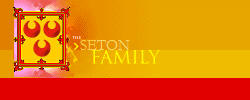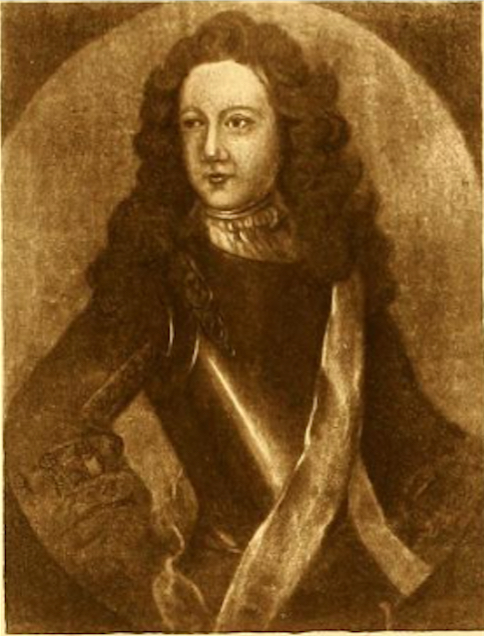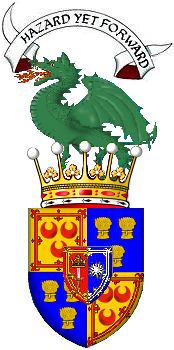George Seton, 4th Earl of Winton (c. 1641 – 6 March 1704) was was a Scottish Royalist, Privy Councillor, and Sheriff of Haddingtonshire, born on the 4th of May 1642, the son of George Seton (the 11th Lord Seton who died before succeeding his father) and Lady Henrietta Gordon. He was intimately connected with with the Duke of Albany and York, who afterwards became King James VII and II and who appointed him Grand Master of the Household in Scotland.
Alexander Nisbet says of this nobleman that "he imitated the extraordinary loyalty of his ancestors; none of them having ever been guilty of treason or rebellion, nor addicted or avarice, nor found with lands of the Church in their possession".
On the death of George, third Earl of Winton, in December 1650, he was succeeded by his grandson as George, fourth Earl, when the latter was ' abroad in his travells in France,' and under ten years of age. On the 12th of May 1653, and again the 28th August 1665, the fourth Earl was served 'heir-male' to his grandfather in his lands in the counties of Berwick, Edinburgh, Haddington, Linlithgow, and Stirling ; and ' heir ' to his property in the counties of Banff and Elgin, 28th September 1655.
He was in Europe for his studies, when at 8 years of age he succeeded to the titles of 12th Lord Seton and 4th Earl of Winton. Notwithstanding his youth, a heavy fine of £2000 was immediately imposed on him by Cromwell's Act Of Grace and Pardon in 1654.
About the same date, a certificate was granted to him, signed by
' Roxburghe, J. Hepburne, Ro. Maitland, Enroll, Tweiddaile, and Angus,' stating
that ' George, now Erie of Wintoune, is bred at his awin house att Seatoun with
his uncle and tutor the Lord Kingstoune in the treu Protestant religioune. That
his father George Lord Seaton depairtit this lyfe in Junnij (?) 1648, being
nather advyseing aiding or assenting to the Invasioune of England at anie tyme .
. . and that the deceased . . . was a nobleman
of a most vertuous and peaceable temper, never carried arms against England in
anie of the warres first or last, and tho' he was called to attend the King
after his arryvall in Scotland, yet soone efter Dumbar he did leive the King,
and be ane passe from his honour the Lord Protector, then Generall of the
English armie, he returned himselff to his awin house of Seatoun.'
His tutor and uncle was Alexander Seton, 1st Viscount and Lord Kingston, by whom he was brought up "in the true
Protestant religion", thus severing the long attachment of his family to the
Catholic Church. On 19 June 1656, Lord Kingston reported to the Haddington
Presbytery by order of the Synod that Lord Winton 'had hitherto been educated in
the Protestant Religion and his education should still be carefully attended
to'.
From the Forfeited Estates Papers in H.M. General Register
House, Edinburgh, in addition to numerous details relative to ' claims of
creditors,' we obtain some interesting information respecting the fourth Earl of
Winton. Thus we learn, from an undated document, that ' Mr. Christopher Seton,
brother to the Earl of Winton, died before the Earl, and that the Earl succeeded
to any effects he had.'
A receipt for £/\.o Scots, dated at ' Linlithgow, nth March 1657,' embraces the
Earl's 'proportion of the moneth's maintenance imposed upon the Schyre for
defraying of the charges of those commissionat for bringing home of the King in
anno 1650 yeiris.' The year following (1658) we find another receipt, signed at
Niddry, by Alexander Reid, ' Collector of the cesse of Kirklistoun parish,' for
the sum of ' nyntein pound Scotes,' for ' his Lordship's proportion of a baggage
horse, and a legge of one imposed upon the parish to goe for Lochaber for the
use of the Inglish in this present month of June.'
Seven years later (15th August 1665) there is a discharge by George, Earl of
Winton, narrating bond by Hew, Earl of Eglintoune, Lord Montgomerie and
Kilwinning, as principal, and with him Alexander, Lord Montgomerie, his eldest
son lawful, Robert Lord Sempell and Glasford, William Lord Cochrane of Paisley
and Dundonald, Collonel James and Generall Major Robert Montgomerie, brother-german
to the said Hew Earl of Eglintoune, and Robert Montgomerie of Heshilheid, as
cautioners to the said Earl of Wintoun for 25,000 merks Scots dated the . . .
day of ... . 1662 ; and the said Earl of Eglintoune, by himself and others in
his name, had repaid the said 25,000 merks. Therefore the said Earl of Wintoun
not only had delivered back again to the said Earl of Eglintoune, but also now
discharged him and all others concerned of the same.
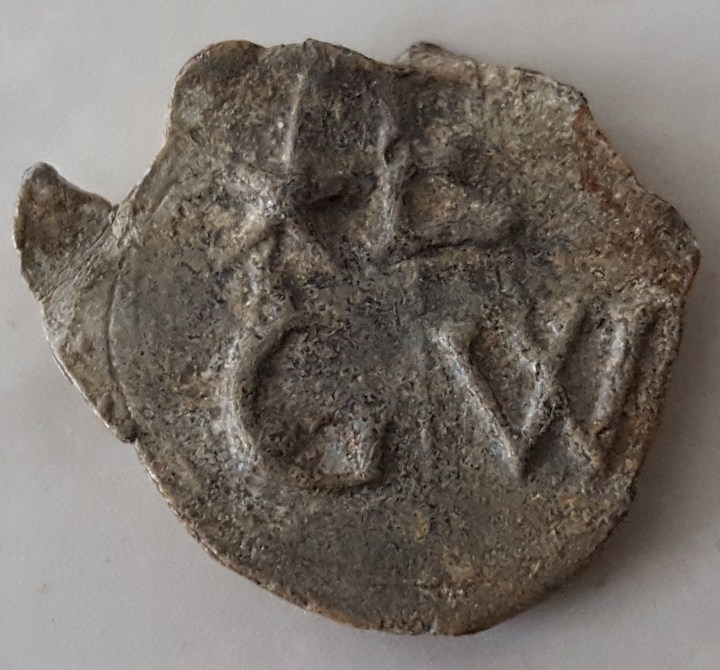 According to Nisbet, Lord Winton was educated in France, both at
court and camp, where he accomplished himself in the knowledge of arms and arts
: and gave an eminent proof of his conduct and bravery at the Seige of Besancon
in Burgundy ' in 1660.
According to Nisbet, Lord Winton was educated in France, both at
court and camp, where he accomplished himself in the knowledge of arms and arts
: and gave an eminent proof of his conduct and bravery at the Seige of Besancon
in Burgundy ' in 1660.
Lord Winton was accomplished in the knowledge of arms, and gave proof of his
skill and gallantry serving with the French army at the siege of Besançon in
1660. Returning to England with a brilliant reputation he was graciously well
received by King Charles II, who appointed him a member of the Privy Council of
Scotland, and give him command of the East Lothian Regiment of Foot, under
General Dalyell, at Pentland against the Covenanters in 1666, following which he
defeated the rebels at Pentland.
In Fraser's Stirlings of Keir there are three letters from the fourth Earl of Winton, all dated from Edinburgh in the year 1664, to 'the much honoured the laird of Keir' (Sir George Stirling), relative to a cautionary obligation in behalf of Sir George Hamilton, arising out of a debt incurred by the writer's grandfather, the third Earl of Winton. At the close of the last letter, he says : ' The caice of my affaires is such that I professe I dare not promise to doe anything towards your satisfaction, but on the contrarie must be yett againe an ernest suiter for your patience and forbearance at this term also. I have so much experienced your civilities and kyndnes that in respect of my present necessitie, I must still presume vpon your old favoures, and remaine confident of the continuance of them at this time.'
A letter to the Earl of Lauderdale, dated ' Edinburgh, 3d
January 1668,' signed by Lord Winton and eleven other noblemen and gentlemen,
begins as follows : ' Sir Walter Seatoun as one concerned with us being Heretor
of coall works and a manufactory of salt within this kingdome did in Aprile 1665
so represent the sad conditione q r in wee wer involved by the frequent
importation and consumption of fforaigne salt imployed for domestick use that
your Lo. was pleased to offer the same to his Ma tie's Royall consideration,
whereupon his Ma tie was pleased to impose y e somme of twelve pound Scots upon
each boll of fforaigne salt imported.' This is followed by an appeal for further
favour. The seal of the letter bears the Winton arms under an Earl's coronet.
On the 5th of December 1668, the Earl of Winton writes to the same nobleman, '
His Majestie's Secretarie for Scotland,' soliciting the King's licence to go
abroad ” probably to Holland. Among other things he says : ' Efter serious
reflexion on my whole concernments, I find it most necessarie for the good of my
famielie and convenient for myselfe ' ; and signs ' Your Lo. most affectinat
cousing and humble servant, Wintoun.' The letter was probably written at Yester,
as the seal bears the Tweeddale crest, motto, and coronet, and Lord Tweeddale is
referred to at the commencement.
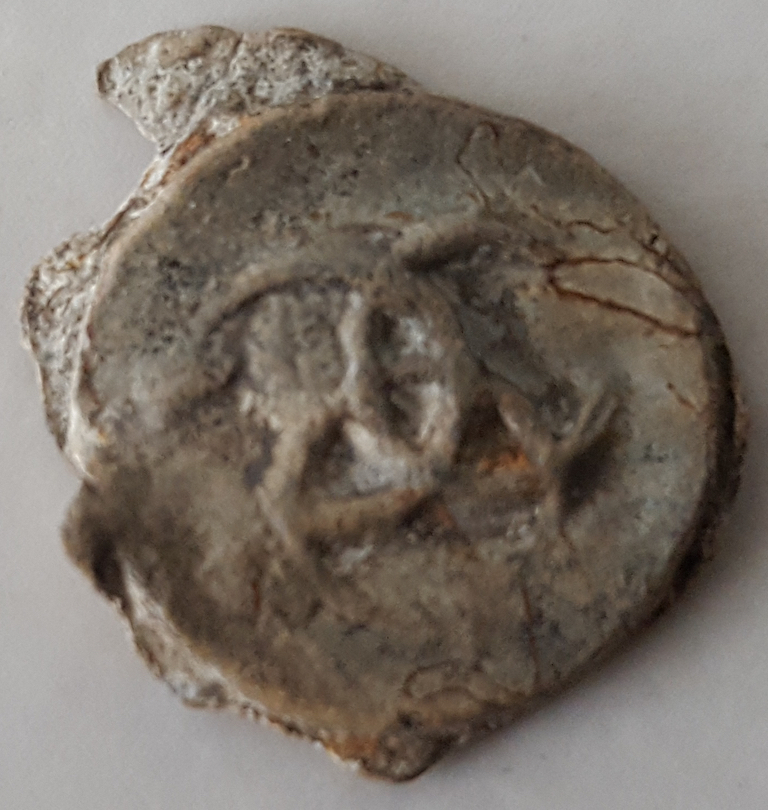 In 1669, Professor Sinclair of Glasgow had dedicated his Ars
nova et magna gravitatis et levitatis ; sive dialogornm fthilosophicorum libri
sex de aeris verd et reali gravitate, etc., to the fourth Earl of Winton ; and
again, in a very strong strain of flattery, the same writer, in 1685, inscribed
the first edition of his curious and very rare work, Satan's Invisible World
Discovered, to his old patron. He compliments his
In 1669, Professor Sinclair of Glasgow had dedicated his Ars
nova et magna gravitatis et levitatis ; sive dialogornm fthilosophicorum libri
sex de aeris verd et reali gravitate, etc., to the fourth Earl of Winton ; and
again, in a very strong strain of flattery, the same writer, in 1685, inscribed
the first edition of his curious and very rare work, Satan's Invisible World
Discovered, to his old patron. He compliments his
Lordship on the acuteness of his ' ingine,' and the profoundness of his
knowledge, adding that ' there is no theme which I am able to treat of, or
thesis which I am able to publish, but your Lordship is able, by your power and
authority, to protect it, and by your reason to defend it.' The Dedication
eloquently recounts the ' valiant atchievements ' of Sir Christopher Seton, the
magnanimity of the governor of Berwick, the important acts of Queen Mary's
devoted adherent, and the forensic skill of Chancellor Seton. The learned
Professor then refers to the Earl's own remarkable services to science in his '
subterraneous and invisible World ' ” his 'meanders and boutgates,' mines and
levels, deep pits and air-holes, mechanical engines and ' moluminous rampier ' ”
and describes the Earl as ' the greatest coal and salt-master in Scotland, who
is a nobleman, and the greatest nobleman in Scotland, who is a coal and
salt-master ; nay, absolutelie the best for skill in both of all men in the
nation.' After alluding to the ' fruitful cornfields ' around his ' dwelling
house at Seton,' the Professor thus concludes his paneygric : ” ' In a word,
your affability in converse, your sobriety in dyet and apparel, your friendship
and kindness to your friends, have indeared all men to you ; so that I may say,
If your predecessors were famous of old for their feats of war, in the time of
war, so is your Lordship famous for your arts of peace, in the time of peace.'
In 1679, Lord Winton again commanded the same regiment and went upon his own charges, with all his vassalls, in noble equipage, in his Majestie's army of 14,000 men, commanded by the Duke of Monmouth, generall thereof, to Bothwell Bridge, against the army of the West-country rebells ; att which place the said rebells were totally defeat.'
After his return to Seton Palace, he royally entertained the Duke of Monmouth and all his officers, ' Scots and English' ” the wife of the said Duke being Duchess of Buccleuch, and ' cosigne german, by the mother's side, to the Earle his father.' In point of fact however, the fourth Earl of Winton's father, George, Lord Seton, was cousin-german to the father of the Duchess of Buccleuch (the wife of Monmouth), and first cousin once removed to the Duchess herself.
_________________________
WRECK OF 'GLOUCESTER' FRIGATE
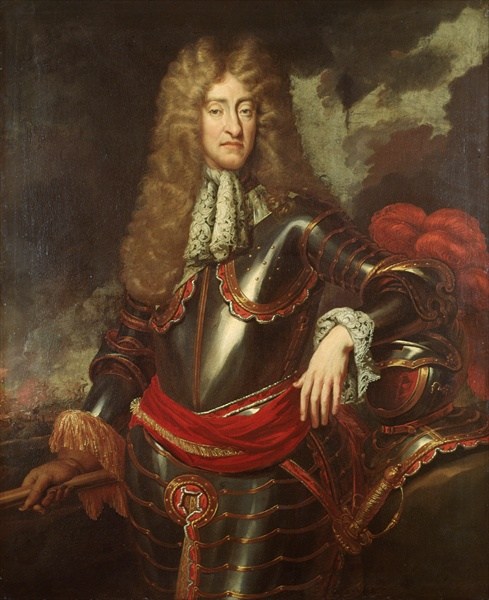 A
letter addressed to the Duke of Lauderdale, dated ' Edinburgh, 15th June 1679,'
and signed by Lord Winton and fifteen other noblemen and gentlemen, as Lords of
the Privy Council, refers to the Duke of Monmouth having been appointed to the
command of the Royal Army ; and ten months later (22nd April 1680), he and nine
other noblemen, including Mar and Linlithgow, communicate with the Duke in
regard to ' the M'Lanes invasion of Tirie.' From the published Extracts from the
Records of the Burgh of Stirling it appears that the fourth Earl of Winton was
made a burgess and guild brother of that historic town, on the 4th of February
1681, along with the Duke of Albany and York (afterwards King James VII and II)
and several other noblemen and gentlemen.
A
letter addressed to the Duke of Lauderdale, dated ' Edinburgh, 15th June 1679,'
and signed by Lord Winton and fifteen other noblemen and gentlemen, as Lords of
the Privy Council, refers to the Duke of Monmouth having been appointed to the
command of the Royal Army ; and ten months later (22nd April 1680), he and nine
other noblemen, including Mar and Linlithgow, communicate with the Duke in
regard to ' the M'Lanes invasion of Tirie.' From the published Extracts from the
Records of the Burgh of Stirling it appears that the fourth Earl of Winton was
made a burgess and guild brother of that historic town, on the 4th of February
1681, along with the Duke of Albany and York (afterwards King James VII and II)
and several other noblemen and gentlemen.
On the death of the Duke of Lauderdale, in 1682, the fourth Earl of Winton was
appointed to the office of Sheriff of Haddington ; and in May of the same year
he accompanied the Duke of Albany and York from London to Edinburgh, in the '
Gloucester ' frigate, which was wrecked on the Yarmouth Sands, through the fault
of the pilot. A signal-gun brought boats to the rescue, and ' the Duke and
several other men of importance were taken from the vessel, just before she went
to pieces.' No fewer than 150 persons, of whom eighty were ' men of quality ' ”
including the Earl of Roxburgh (whose widow survived him for seventy-one years)
and the Laird of Hopetoun ” were drowned. Among those who escaped were the Earl
of Winton, and Sir George Gordon of Haddo (afterwards Earl of Aberdeen),
President of the Court of Session, who had just been appointed Chancellor of
Scotland.
_________________________
In 1682 he was appointed Sheriff of Haddingtonshire, and in May of the same year
he accompanied the Duke of York from London to Edinburgh in the frigate
Gloucester, which was wrecked, with great loss of life, on Yarmouth Sands. An
interesting letter written to Mr. Hewer from Edinburgh, on Monday 8 May 1682, on
this disaster is found in the correspondence of Samuel Pepys who was also with
the Duke of York.
Importantly, in 1685, Lord Winton was appointed by King James
VII and II as Grand Master of the Household in Scotland.
Also in 1685 Winton was again in action with his regiment, against the Earl of
Argyll. He yet again accompanied his regiment, 'upon his own expense, with his
vassalls,' to the west country, in the expedition against the Earl of Argyll,
and was in the royal army, under the command of the Earl of Dumbarton. After
Argyll's defeat, he was given in custody and keeping to the Earle of Winton, who
sent the prisoner Argyll to the Castle of Edinburgh.'
The same year, Lord Winton appears to have been appointed by James VII. to the
important office of Great Master of the Royal Household, which had been held by
at least two of his ancestors ” John, second Lord Seton, in the time of King
James I, and George, seventh Lord Seton, during the reign of Queen Mary, ' which
office of Great Master-Household, by reason of the said Lord George his great
troubles for Queen Marie, and long banishment for his loyall service to her,
was, in the interim, till King James the Seventh, exercised by the Earles of
Argyle.'
As a learned individual, Professor Sinclair presented him with a curious and
rare work entitles Satan's Invisible world discovered - or A choice collection
of relations anent devils, spirits, witches, and apparitions in 1685. The
lengthy 'Epistle Dedicatory' is in a vein of exaggerated praise, somewhat
relieved by a description of the Earl's coal-mining operations, in which he
brings in the name of Anthanasius Kircher, the Jesuit, whom most people have
heard of only through the Kircherian Museum in the Roman College, at Rome, but
who was one of the first natural philosophers and scientists of the age.
On the 31st of July 1686, a charter was granted to George, fourth Earl of Winton, Lord Seton and Tranent, of the earldom, lordship, and regality of Winton, and his title, honour, and dignity, ' to him and the heirs male of his body ; whom failing, to whatever person or persons he might think proper to nominate, at any time of his life, etiam in articulo mortis, and the heirs male of their bodies ; whom failing, and if he did not make such nomination, or did revoke or cancel such nomination, then to his heirs male ; whom failing, to his nearest heirs and assigns whatsoever, the eldest daughter or heir female succeeding without division, and marrying a gentleman of the name of Seton, or who should assume the name, and carry the arms of the family of Winton.'
A special Royal Charter dated 31 July 1688, was re-granted to him of the Earldom of Wintoun, to him and the heirs male of his body, which failing, to whichever person he might nominate and the heirs male of their bodies, with remainder to his heirs male, and failing these to his nearest heirs and assignees whatsoever, the eldest daughter or her female succeeding without division, and marrying a gentleman of the surname of Seton, or who would assume that surname and carry the Wintoun Arms.[1] George, 4th Earl of Winton, married Christian (d. 1703), daughter and heiress of John Hepburn of Adinstoun in East Lothian.
In 1691-93 he was back in Holland, at Amsterdam and at Leyden,
where he met travellers and learned men in whose company he delighted, as he was
much given to mathematics and physical science.
In the time of this Earl (1695), the parish of Gladsmuir was formed by
abstractions from the neighbouring parishes of Haddington, Aberlady, and Tranent,
and a church was built on a ridge of moorland, which was known by the
appropriate name of Gledesmuir. As the parishes of Haddington and Tranent
contributed the largest portions to the formation of the parish of Gladsmuir, it
was agreed that the patronage of the new church should alternately belong to the
Earls of Haddington and Winton ; the former being patron of Haddington and the
latter of Tranent. Lord Haddington's right was soon afterwards transferred to
the Earl of Hopetoun, while Lord Winton's fell to the Crown, by forfeiture, in
1716.
The Earl did much to improve his property and to benefit the public. He built a
new harbor at Cockenzie, called, for distinction of the west harbour, " Port
Seton", which still exists by this name, and continues to this day and has been
revived by the people of Edinburgh people as a modest summer resort.
LORD WINTON'S COMMISSIONERS
On the 30th of December 1684, Sir James Richardson of Smeatoune grants a
discharge to ' William Seatoune, one of the Gentlemen of his Majesties Guard,'
in name of George, Earl of Wintoun, for 83 Scots in part payment of a
considerable sum 'resting owing' by the Earl, under a bond executed in 1668.
A few years previously (25th August 1679) the sum of ^11 Scots appears to have
been paid to the same ' Gentleman of the Guard,' for money ' lent to my Lord '
when going to Gosford to meet with the Chancellor.
From a legal document, signed at Edinburgh in January 1673, in presence of
Robert Seatoun and George Young, ' Chamberlains to the Earl of Wintoun,' we
learn that the Earl's Commissioners, appointed by him in August 1670, were John
Earl of Tweeddale, Alexander Earl of Kincardine, William Earl of Dundonald,
Alexander Viscount of Kingstoune, Sir John Seton of Garmiltoun, Charles Maitland
of Haltoune, 'his Majesties Thesaurer Deput and ane of the Senators of the
Colledge of Justice,' James Setons, elder and younger of Touch, Sir James Dundas
of Arnestoun, George Seton of Barnis, John Seton of St. Germans, Sir Walter
Seton of Abercorne, and ' Mr. Alex- ander Seton of Pittmeddin, Advocat.'
In a book of Accounts we find that the ' rent of ane furnished Ludgine from the
25th of January 1675 till the 4th of November 1676, being 93 weeks, at 30s. a
week,' amounted to ^1674 ; while the cost of breakfasts, dinners, and suppers,
from 1st December 1676 to 18th March 1677, was ^"310, 19s. 8d.
On the 13th of March 1678, Mr. Edward Wright, Advocate, obtains letters of
horning and poinding against Lady Marie Seton (youngest daughter of the third
Earl of Winton) and the Earl of Carnwath, her husband, for a debt contracted in
1676; and a few days afterwards he arrested in the hands of Lord Winton ';£iooo
Scots, less or more, due and addebted by the said Lord to the said Lady Marie
and her husband.' The matter appears to have been settled before the close of
the year.
At Seton, on the 4th of July 1678, the Earl of Winton grants a receipt to Mr.
Alexander Drummond, his 'servitour,' for ^"150 sterling 'delivered to our
servants for the expense of our journey to England ; while a packet, dated 5th
October 1680, is entitled ' Instructions of money depursed in order to the Duke
of Monmouth's Treat,' which was given by the Earl in July 1679.
On the 6th of July 1682, the Earl of Dundonald writes from Edinburgh to the Earl
of Winton, mentioning that when in Edinburgh he had not seen the latter, ' being
away with his Royal Highness' ; and that he 'was exceedingly rejoiced to hear of
his safe return after so hazardous a voyage.' He further states that when he was
in Edinburgh ' your cuising St. Germans was with me regretting his sad
condition, and desirous to be at ane settlement with your Lordship.'
A few weeks later (27th July) we find a letter to Lord Winton from James Lauder,
Clerk, Haddington, anent his Lordship meeting with the Commissioners of Excise,
to consider the grievances of the brewers, in connection with the heavy
exactions imposed upon them.
An unsigned memorandum, also dated July 1682, is thus indorsed : ” ' Double
(copy) of the Licence the Earl was to subscribe anent Sir John Ramsay of
Whitehill and his servants transporting pan wood from the coal heughs in Fawsyde,
pertaining to him in perpetuity, and to the Earl in superiority, through the
lands of Mylls to the lands of Prestoun and Prestonpans.'
On the 8th of October 1682, Lord Winton writes from Seton to Sir Walter Seton,
asking him to meet him in Edinburgh, as he required to attend a conference of
the council for adjourning the Parliament.
In a document entitled, ' my Lord Wintoun his accompt to Alexander Reid,
Goldsmith,' for silver-plate, etc., amounting to ^"505, 12s., the following item
occurs : ” ' Resting for ane pair of silver clasps gilded with gold for your
Lordship's brother, Mr. Alexander Seton, is . . . . . . 003 00 00.'
The account is receipted at Tranent, 28th March 1 683 ; and about the same date
we find a contract between the Earl of Wintoun and William Halyburtoun, ' Calsey-layer
in Musselburgh,' for all calsey-work required on the estate. The contract is
signed at Seton, George Seton, son of Sir Walter Seton of Northbank, being a
witness.
The following year (12th March 1684), Robert Seaton, 'Coalgrieve' to the Earl of
Winton, pays .£100 Scots to John Seaton for horses for the use of the Earl ;
while on the 5th of August we come across a ' Vendition ' to the Earl, by Boone
Jacobsone, merchant in Copenhagen, and Hans Jansen, skipper, of the good ship
called the ' Sun,' belonging to Henricks Eme, coppersmith to the King of
Denmark.
The following is an excerpt from a curious unsigned memor- andum (but probably
holograph of the Earl), dated 'Edbro 22 Feb r . 1686,' and addressed to Captain
Colinson : ”
' 1. We are resolved to continue of our Servants at Seton, yourself, George
Seton, Walter Ramadge, Faney Young, and Jeane Ronald and noe mor, therefor 'despatch
the remanent of our men and women servants the week after our journeying, and
pay them their fials (wages) until the ensewing terme of Whit- sunday nixt.
' 2. Likewise you are to cause take doun al the furniture at our Lodging in
Edinburgh, in our chalmer and drawing roume, and lay it in the chalmer, and
continew Johne Macknaughton's wife to looke to the said Lodging ; which servants
above you are to allow them four shillings Scots per diem for their dyet, and
for your own dyet and George Seton with your servants, you are weekly to provyde
yourself of fresh victuals by money, seeing wee have ordered our poultry and
rabbits to be converted in money.
' 3. Likewise cause brew one tune of the best Aile can be made, and sent in to
my Lo/ Chanclour one hogshead, to the K. Advocat one hogshead, to Sir Hew
Dalrymple one hogshead, to Blair the Chancellour's servant one hogshead, and one
hogs- head to Dr. Irving. Let this be of the best and whytest malt.'
In the same year (1686) there is an account 'resting to several persons ' by
Andrew Seton, master of the Earl's ship ' Dragon,' for the ' outrick ' of the
said vessel, amounting to ^316, 15s. iod. Inter alios, the sum due to Robert
Seton, Munckmylne, is .£52, 16s.
Two years later (15th March 1688) we find a receipt, dated at Port Seton, by
John Crawfurd in Dunce to George Seton, Chamberlain to the Earl of Winton, for a
hogshead of French wine ” Robert Seton in Seton being a witness ; and a few days
afterwards, part payment (^12) is made of an 'accompt of entrie and deutie payed
for the Earl of Wintoun's use be George Seatone, Taylior, for entering and
transferring his Lordship's trunk and several other things that came from
London, from Kirkaldie to Leith,' on 15th February 1687. The receipt is granted
to Sir Walter Seton and others, as the Earl's commissioners.
On the 5th of October 1688 there is a 'Tack,' signed at Seton and Edinburgh,
between the Earl of Wintoun, on the one part, and Alexander, Earl of Kincardin,
on the other part, wherby for the love, favour, and respect he had for him, the
Earl of Wintoun let to the Earl of Kincardin, his Lodging and Dwelling House in
the Canongate of Edinburgh, for five years ” the tack-duty being a penny Scots
yearly. Mr. Alexander Seton of Pitmedden is a witness.
In 1689 a petition is presented to the Earl of Winton by Robert Ballenden, smith
in Cockenzie, for payment for work done at the salt-pans in June 1686, on the
order of his Lordship's commissioners, during the Earl's absence from the
kingdom. On the 13th of September of the same year the Earl signs a commission,
at Seton, narrating a former commission in favour of Sir Walter Seton of
Northbank, Sir John Ramsay of Whitehill, and Captain Robert Colliesone,
discharging them of their intromissions, and giving a new commission to James
Seton of Touch, and the said Sir Walter Seton and Sir John Ramsay to
be his factors and commissioners. The deed is signed in presence of George
Seton, son lawful to the said Sir Walter, and William Seatone, servitor to the
Earl.
Among the lands mentioned in a sasine to the Earl of Winton of the 24th of
December 1688, are 'the Kirklands of Seton, sometime possessed by Robert Seton,
now called the Kirklands of Tranent, with the heritable office of Bailliary of
said Kirklands.'
An undated letter to Lord Winton from ' Ja. Leviston ' intimates his father's
death. The writer states that he knew the necessity of his Lordship ' not
stirring from home in this troublesome time,' but he requests the Earl 'to
permit Mr. Christopher to honour his father's memory, by being at his interment
at Carstairs.'
On the 10th of December 1692 there is a sasine in favour of James Smith, Bailie
of Tranent, of the lands of Adingston and others. The bailie in the sasine was '
constituted ' by Sir Alexander Seton of Pitmedden, Knight and Baronet, James
Seton of Touch, and Mr. John Creighton, commissioners appointed by George, Earl
of Winton, superior of the said lands.
Five years later (9th April 1697) — Sir Walter Seton, advocate, acting as his
attorney ” a sasine of certain lands, comprising, inter-alia, ' the temple lands
of Seton, sometime occupied by George Seton, messenger,' is taken in favour of
George, Lord Seton, eldest lawful son of George, Earl of Winton ; and on the 2nd
of July 1698 we find an instrument of resignation ad remanentiam by Mr.
Christopher Seton, brother-german of the Earl of Winton, in favour of the Earl,
of an annualrent of 2400 merks ' effeiring to 40,000 merks upliftable furth of
the Earldom of Winton.'
A few months later (21st November) there is a minute of a sasine infefting
George, Earl of Winton, as heir to George, (third) Earl of Winton, ' his goodsir,'
in two tenements of land on the north side of the ' High Street of Canongate.'
In a complicated claim against the Winton estate, after the forfeiture, in 1717,
it transpires from a bond referred to that the writer of this letter was
probably years afterwards, on the death of his uncle, James Livingstone, fourth
Earl of Calendar, became fifth Earl of Linlithgow, who succeeded his father in
1692, and the fourth Earl was at Amsterdam in August 1691, accompanied by Petrus
Winkelsells and William Seton, his servants, and Sir John Ramsay of Whytehill;
and about two years later (March 1693) he appears, from another claim, to have
been at 'Leyden in Holland.'
Finally, from a third claim, signed at Edinburgh in 1718, we find that Robert
Innes, merchant there, supplied ' merchant wares ' at the time of the fourth
Earl's ' funeralls,' to the amount °f £555> I2S - Scots, by order of Mr. James
Seton, brother-german to the Viscount of Kingston.
ISSUE AND SUCCESSION
He was twice married: firstly to Lady Mary Montgomerie, daughter of Hugh Montgomerie, 7th Earl of Eglinton and Lady Mary Leslie, on 4 September 1662; secondly to Christian Hepburn, daughter and heiress of John Hepburn of Adinstoun, before 6 March 1682, and she herself died in 1703.
The Fourth Earl of Winton died on 6 March 1704 at age 61.
From his first marriage to Lady Mary Montgomerie, eldest daughter of Hugh,
seventh Earl of Eglinton, ' and eldest sister daughter of the Earle of Rothes,
Lord High Chancellour of Scotland,' he had one daughter, Lady Mary, who died
when only three years of age.
By his second wife, Lady Christian Hepburn, daughter and heiress of John Hepburn of Alderston (Adinston) in the county of Haddington, he had two sons :
1. George, his successor as Fifth Earl of Winton.
2. The Hon. Christopher Seton, who died the 5th of January 1705.
Of these two sons, Nisbet, the heraldic writer, says that they presented ' such
a lyvely transcript of the raire qualities q ch ennobled y r predecessors y 4
they may deservedly be termed the worthy progenies, successores of y r noble
ancestors.' According to Robert Mylne, ' Mr. Christopher wes cut of by death, 5
Jan. 1705, to the great regrate of all that knew him. The drunken Earle of , who
had been at Seton with him at his christening, drunk him so hard that he kust
(cast) him in a feaver, whereof he died. Robert Mylne, wryter, sould have been
with them, and for whom the coach and they stayed severall houres, but he kept
out of the way.' *
Speaking of the family of Lord Winton's second wife, Christian
Hepburn, heiress of Adinston, Nisbet states that they were ancient barons in
East Lothian, 'who, since King Robert ye Bruce, were heritable standart bearers
to ye Hous of Setoun ; and it is observable (he adds) that she only, and none of
the former ladyes, brought any lands to the fortoun.'
Her coat, as a widow, is engraved in Nisbet's Heraldic Plates, recently edited
by Messrs. Ross and Grant, along with the names of the quarters on her funeral
escutcheon, which are here subjoined, and from which it will be observed that
her maternal grandmother was a Seton of Cariston.
After enumerating the fourth Earl's various military achievements, Nisbet declares that he imitated ' y e extraordinary loyalty of his predecessors, never any of y m from the first Dougall to this day being guilty of rebellion or treason, 4 nor addicted to avarice, so y 1 never was there a remission in y r charter chist, nor any of the lands of the church in their possession.' ' This Earl,' he states, ' resumed the surtout azur, charged with a blazen starr or (which of laite was layd asyde), with this suitable motto, " Intaminatis fulget honoribus." '
Lord Winton's eldest son, Lord Seton, appears to have quarrelled
with his father, and to have resided for some years abroad, working as a
journeyman-blacksmith ; and when he succeeded to the Earldom ' no man knew where
to find him, till accident led to the discovery.'
According to Nisbet, Lord Seton ' went abroad to his travels in June 1700, and
before his return to Scotland his mother died, 18th November 1703, and was
interred in the north aisle of the Church of Seton. His father, the fourth Earl,
died about four months afterwards, on the 6th of March 1704.'
From the brief record of the fourth Earl's ' Testament Dative and Inventory of
Goods,' it appears that it was given up by ' Mr. William Colt of Garturk, Dame
Elizabeth Syme, relict of Sir Robert Colt, Advocate, and William Robertson, one
of the under clerks of Session, only executors dative decerned as creditors to
the said Earl ' ; and that the sum of the Inventory, including the debts due to
the deceased, amounted to xvj m lib.
Nisbet further states that Lord Seton ' returned home from his travels the 1st
of November 1707,' and that he buried his father, 'with great pomp and
solemnity,' in the aisle beside his mother. 'The achievement then used,' Nisbet
adds, 'was, quarterly 1st and 4th or, three crescents within a double tressure,
flowered and counter- flowered gules, for Seton ; 2nd and 3rd azure, three garbs
or, as a coat of pretension to the earldom of Buchan ; over all, by way of
surtout, an escutcheon parted per pale — on the dexter, gules, a sword
pale-ways proper, hilted and pommelled or, supporting an imperial crown within a
double tressure of the last, as arms of special concession by King Robert the
Bruce ; and on the sinister, azure, a blazing star of twelve points argent,
within a double tressure counter-flowered or, for the title of Winton. Which
arms were adorned with crown, helmet, and volets x suitable to the quality ; and
in place of the wreath, a ducal crown ; and upon it, for crest, a dragon vert,
spouting fire proper, with wings elevated and charged with a star argent ;
above, on an escrol, for motto, Hazard set forward ; supporters, two mertrixes
proper, collared or, and charged with three crescents gules; to their collars
chains are fixed, passing between their fore-legs and refiexing over their backs
; upon an escrol, coming from behind the shield, and passing over the middle of
the supporters, are these words, Intaminatis fulget honoribus, relative to the
surtout ; and on the compartment upon which the supporters stand are these
words, Invia virtuti via nulla, the old motto of the family.'
The Succession of George Seton, Thirteenth Lord Seton and Fifth Earl of
Winton.
The funeral solemnity of the fourth Earl already referred to was of course a
re-interment , since as his son and successor, the fifth Earl, did not return to
Scotland for upwards of three and a half years after his decease. This seems to
be fully confirmed by a printed ' Information ' for the fifth Earl of Winton
against the Viscount Kingston, James Seton his brother, and the laird of
Drumelzier, dated 19th July 1711, and signed by 'David Dalrymple' (afterwards
Lord Hailes), relative to the unlawful intromissions of the defenders with the
house, furniture, jewels, plate, coal, salt, rents, etc., of the pursuer. It is
there stated that the defenders ' pretend to alleviate the circumstances of
staying in the House of Seton, and the having carried goods from thence to
Whittinghame, alleging that the coming to the House was to assist at the late
Earl's funeral. . . . But this excuse ought never to have been mentioned, for it
is too well known with what atrocious circumstances of contempt the defenders
pretended to dispose of the late Earl's body, and the body of Mr. Christopher
his son, at that time.'
On the other hand, in Mr. Riddell's printed ' Case ' for Lord
Eglinton (p. 22) it is stated that the ' pious office ' of burying the fourth
Earl and his son Christopher was most naturally discharged by the Kingston
family, as the ' next relations ' of the deceased.
In 1708, Robert Calder 1 dedicated his edition of the Genuine Epistles of St.
Ignatius to ' The Right Honourable and truly Noble George, Earl of Winton, Lord
Seton, Baron of Tranent, etc' Following the example of Professor Sinclair, he
more briefly refers to the antiquity and loyalty, as well as the valiant deeds,
of the Seton family. Not anticipating the impending change of circumstances, he
says : ' And for all the alterations and changes that have come upon great
fortunes, very few in the kingdom have so plentiful an estate as your Lordship,
and none so contiguous, compact and convenient, both for sea and land, for
casual and real rents, for advantages of salt and coal, with the accommodation
of pleasant and well inhabited towns and villages, all belonging to yourself,
and that without any addition to it by
Marriages, Forfeitures, or Kirk-Lands.' After mentioning the traditional
characteristic of the 'House of Seton' for its 'just dealing,' which ' both the
representatives and the cadets take great pleasure in telling,' Calder concludes
as follows : ' 'Tis well known of your Lordship that you did bear the yoak in
your youth, and you know what injuries and afflictions are ; and 'tis as well
known, that if justice in dealing, owing no man anything but love, admirable
temperance, looking to business, profitable recreations, spending of time
regularly and usefully, shunning whatever leads to riotousness and licentious
living, abhorring the scandalous sparkishness of a loose age ; if these (I say)
be a mean to preserve and exalt a family, then surely your Lordship's cannot
perish in your own person. And therefore I conclude in
the words of an English poet : ' " Do as your great progenitors have done, And
by your virtues shew yourself their son." '
In a general retour of the service of George, fifth Earl of Winton, to his
father, dated 4th July 17 10, the parties are thus designated : ' Quondam
Georgius Comes de Winton, etc. Pater Georgii nunc Comitis de Winton, Domini
Seton et Tranent, latoris praesentium, ejus unici legitimi filii nunc viventis
procreat. inter ilium et quondam Christianam Comitissam de Winton, ejus sponsam.
Obiit ad fidem et pacem S. D. N. Reginae nunc regnantis ; Et quod dictus
Georgius, nunc Comes de Winton, est legitimus et propinquior haeres masculus et
linear dicti quondam Georgii Comitis de Winton, ejus patris.' This service
proceeded in the Macers' Court, in Edinburgh, under a commission issued from
Chancery, before a jury consisting of fifteen Senators of the College of
Justice, including James Duke of Montrose, John
Earl of Lauderdale, Lord President Dalrymple, Adam Cockburn of Ormiston, Lord
Justice-Clerk, and Sir Robert Dundas of Arniston.
Shortly before this service the Viscount Kingston, who was next heir to the
Winton title, having been induced to throw doubts upon the Earl's legitimacy,
the latter was compelled to vindicate his status. Two witnesses were produced by
him who were present at the marriage of his parents, and documents were found in
the family charter-chests in which the Earl was designated as ' our eldest
lawful son ' by Dame Christian Hepburn, ' our spouse,' Countess of Winton. The
two witnesses were Sir John Ramsay and James Smith, Clerk of Tranent. The latter
having been taken ill, the Earl petitioned the Court of Session to have him
examined directly, and the Lords ordered two of the macers to go to Tranent
forthwith and take his oath as to his presence at the marriage.
